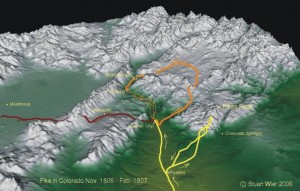Review by Columbine Quillen
Tourism – March 2007 – Colorado Central Magazine
Brave New West – Morphing Moab at the Speed of Greed
by Jim Stiles
Published in 2007 by the University of Arizona Press
ISBN 0816524742
JIM STILES, editor and publisher of the Canyon Country Zephyr, lusts after a Moab before mountain bikers. He yearns for a town without fast food restaurants, t-shirt kiosks, and bike shops. He longs for an Arches National Park void of people, and wants those who go there to stay on the main road. Today, Stiles craves for the place that he fell in love with over 30 years ago, but that place no longer exists.
Just like the famed Edward Abbey, Jim Stiles came to canyon country in search of solitude and natural beauty. And also like Abbey, he was confounded by the tourons that visited his hometown each spring.
Over the years, Stiles grew appalled by the increasing numbers of tourists arriving and the changes they brought. He blames Moab’s most recent transformation on mountain bikers, because Moab has become one of the most popular mountain biking destinations in the world. And along with the bikers, more climbers and hikers also started coming, many of whom use guidebooks to find their way around the remote canyon country. These guidebooks are another of Stiles’s nemeses. According to Stiles, there are now waitlists to go hiking in the more inaccessible parts of Arches National Park, and because there are so many people who want to visit remote terrain, there are companies illegally taking hikers and climbers out to (and onto) very secluded arches.
But what bothers Stiles the most, is that these throngs of people have a blatant disregard for the canyon country’s solitude. He claims that these new tourists travel in packs in the hopes of getting digital photos of themselves doing something cool. And since they only care about the adrenaline rush, they never take the time to look around and enjoy true wilderness.
And the problems such tourists bring do not stop in the wilderness. In the town of Moab, they have driven real estate prices up to a point where working locals can no longer afford a home. They have erected condos where there used to be open space, built million-dollar second homes that use up an abundance of resources, and cluttered the scenery and blocked out views with their resorts. Now, there’s traffic, litter, and all of the other annoying things that come with crowds.
BUT THERE’S ALSO MONEY, something that Moab had a shortage of for most of the 90’s. Moab was a very depressed little town before the mountain biking boom. From 1980 to 1990, it lost almost a fifth of its population, going from 5,333 people to 3,971. Real estate value was at an all time low, shops were boarded up, and the only place with plenty of business was the Church of Latter Day Saints.
But mountain biking transformed Moab, and it became a destination resort. People started buying up real estate, opening businesses, and gentrifying the town. And that’s when Stiles started getting really annoyed.
Stiles is not the only annoyed individual in the West; it’s a common theme out here. But unfortunately, no one has a formula to control rampant growth while preserving the natural resources that brought people to live in these places to begin with. And Stiles doesn’t offer many answers — other than a very benevolent woman named Jennifer Speers who can afford to buy up new developments just to tear them down in order to create open space again. And that’s great, but considering how popular backcountry dream homes have become in the West, even Bill Gates might have trouble making that solution work for very long.
Brave New West is the story of a scenic little town where locals can’t agree on what the future should look like, and also the story of a monumental but fragile landscape that’s been around for countless years, and should be here for countless more. But in order for the town and the countryside to flourish, residents have got to start making decisions about growth — because, as Stiles shows us, growth is inevitable in such places.
We have to make choices if we want our hometowns to remain places where working people can live and thrive because the big developers are arriving and building condos that we can’t afford, cul-de-sacs where there used to be trails, and resorts for people that not too long ago we only read about in magazines. Stiles concludes that you have to fight to keep affordable housing, small businesses, and access to national parks and lands, because if you don’t capitalism will prevail and development will destroy all of the things we cherish about our homes.
Stiles does a good job of presenting rural problems that most of us are all too familiar with, and he wraps his book up with an inspiring call to action. But there’s an obvious problem with his conclusion. The things Stiles wants us to fight for in order to save our small towns aren’t working. Instead, the very things that he and other westerners are fighting so hard to preserve — nature, wildlife, open spaces, beautiful landscapes, historic small towns, and affordable real estate — are drawing the developers like flies. And presuming more people keep coming and building more homes and roads and stores, year after year, the things Stiles loves most — solitude and isolation — will be lost forever.
Although a lot of people in Central Colorado will surely commiserate with the author and will doubtlessly like this book, Stiles does a better job of sharing our complaints than of proposing any resolutions for them.
Brave New West has an official publication date of March 27. Columbine Quillen grew up in Salida when it was a sleepy backwater, and now lives in Bend, Ore., which now has five McDonald’s eateries.

